Summary
Revista Brasileira de Ginecologia e Obstetrícia. 1999;21(3):177-177
DOI 10.1590/S0100-72031999000300013
Summary
Revista Brasileira de Ginecologia e Obstetrícia. 1999;21(3):177-178
DOI 10.1590/S0100-72031999000300014
Summary
Revista Brasileira de Ginecologia e Obstetrícia. 2016;38(4):177-182
The amniotic fluid volume (AFV) is known as a predictor for the wellness of a fetus. We aimed to investigate whether N-terminal pro-brain natriuretic peptide (NTproBNP) levels reflect AFV abnormalities in otherwise normal fetuses.
We recruited 24 women with isolated oligohydramnios, 23 women with isolated polyhydramnios, and 36 women with normal AFV at a tertiary referral center. NT-proBNP levels in umbilical venous samples and the individual characteristics of the three groups were compared. One-way ANOVA and Kruskal-Wallis analysis of variance were used for multi-group comparisons of continuous variables. When a significant difference was detected, the Scheffe test was performed as a post-hoc analysis. Proportions were compared using the Chi-square (2) test.
Maternal age, body mass indices, weight gained in pregnancy and NT-proBNP levels were similar among the three groups. Apgar scores at 1 and 5 minutes significantly correlated with NT-proBNP levels in all newborns (Spearman's r = 0.23 ; p = 0.03 and Spearman's r = 0.24; p = 0.02, respectively). The umbilical venous NTproBNP levels did not differ between newborns who needed mechanical ventilation and those who didn't (p = 0.595).
NT-proBNP is a biomolecule that may provide insights into the pathogenesis of fetal circulatory problems and subsequent renal failure. Further investigations are warranted.
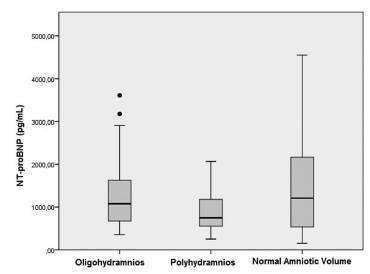
Summary
Revista Brasileira de Ginecologia e Obstetrícia. 2003;25(3):177-183
DOI 10.1590/S0100-72032003000300006
PURPOSE: to evaluate three embryo scoring systems specific for 3-day embryos and to correlate them with positive in vitro fertilization outcome. METHOD: retrospective study of the In Vitro Fertilization Program of the University Hospital, Faculty of Medicine of Ribeirão Preto, University of São Paulo. A total of 137 patients submitted to the transfer of 439 embryos were evaluated. The main outcomes measured were pregnancy and implantation rates. RESULTS: a significant difference in the three scoring systems was observed between pregnant (n=53) and non-pregnant (n=84) patients (p<0.0001). In the first embryo scoring system, in which cell number alone was used, higher pregnancy (70%) and implantation rates (42%) were observed when embryos with a mean blastomere number higher than 8 were transferred. Scoring system 2, based on a total four-point score (cleavage stage, blastomere number, fragmentation and symmetry), showed increased pregnancy (52.8%) and implantation rates (31%) for scores above 2. Scoring system 3, based on cell number and morphological criteria, also showed higher pregnancy and implantation rates with increasing average scores of the transferred embryos. CONCLUSION: the three scoring systems assessed in 3-day embryos were positively correlated with pregnancy and implantation rates.
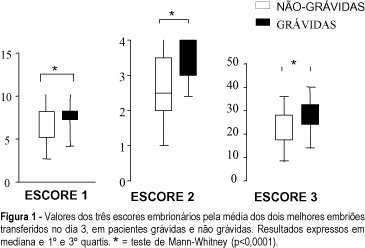
Summary
Revista Brasileira de Ginecologia e Obstetrícia. 2008;30(4):177-181
DOI 10.1590/S0100-72032008000400004
PURPOSE: to evaluate the expression of Bax antigen in the normal mammary epithelium of premenopausal women treated with raloxifene. METHODS: a randomized double-blind study was conducted in 33 ovulatory premenopausal women with fibroadenoma. Patients were divided into two groups: Placebo, (n=18) and Raloxifene 60 mg, (n=15). The medication was used for 22 days, beginning on the first day of the menstrual cycle. An excisional biopsy was carried out on the 23rd day of the menstrual cycle and a sample of normal breast tissue adjacent to the fibroadenoma was collected and submitted to immunohistochemical study using anti-Bax polyclonal antibody to evaluate the expression of Bax protein. Immunoreaction for Bax was evaluated taking into consideration intensity and fraction of stained cells, whose combination resulted in a final score ranging from 0 to 6. Cases with a final score >3 were classified as positive for Bax. The c2 test was used for statistical analysis (p<0.05). RESULTS: the percentage of positivity of Bax protein expression was 66.7 and 73.3% in Groups A and B, respectively. There was no significant difference in Bax expression between the two groups (p=0.678). CONCLUSIONS: raloxifene, administered for 22 days in the dose of 60 mg/day, did not alter the expression of Bax protein in the breast normal tissue of premenopausal women.
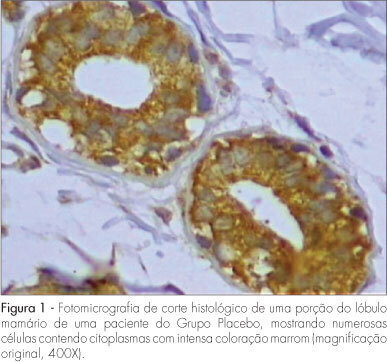
Summary
Revista Brasileira de Ginecologia e Obstetrícia. 2021;43(3):178-184
The present study aimed to explore the opinion and ethical consideration of vulvovaginal aesthetics procedures (VVAPs) among health professionals and medical students in Saudi Arabia.
This is a cross-sectional study performed between January 2020 and April 2020. Data was collected through electronic media, WhatsApp, and emails. The results were analyzed by applying the Students t-test, and correlations were considered significant if they presented a p-value<0.05.
There is significant demand to educate doctors, health professionals, medical students, and gynecologists for the VVAPs to have a solid foundation, justified indications, and knowledge about various aesthetic options. Although female doctors, medical students, young doctors, and gynecologists have more knowledge about VVAPs, all health professionals ought to be aware of recent trends in vulvovaginal aesthetics (VVA). The present analysis determined that VVA should be under the domain of gynecologists, rather than under that of plastic surgeons, general surgeons, and cosmetologists. Themajority of the participants considered that vaginal rejuvenation, “G-spot” augmentation, clitoral surgery, and hymenoplasty are not justifiable on medical grounds.
The decision to opt for different techniques for vaginal tightening and revitalization should be taken very carefully, utilizing the shared decision-making approach. Ethical aspects and moral considerations are important key factors before embarking in the VVAPs purely for cosmetic reasons. Further research is required to determine the sexual, psychological, and body image outcomes for women who underwent elective VVAPs. Moreover, medical educators must consider VVAPs as part of the undergraduate and postgraduate medical curriculum.
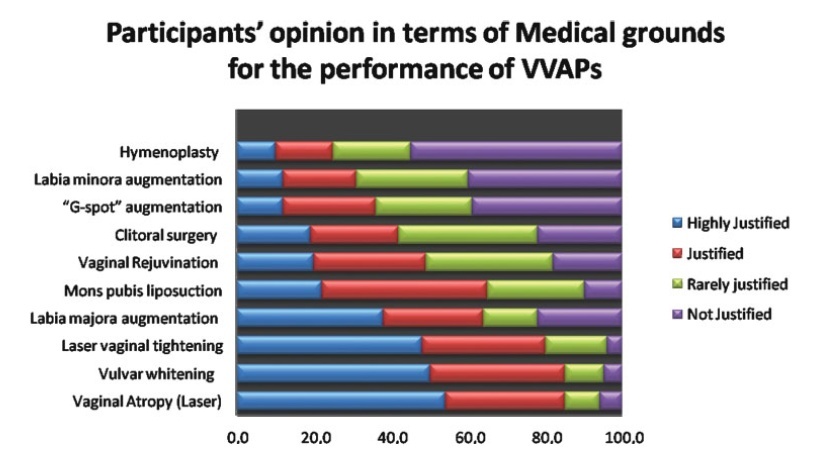
Summary
Revista Brasileira de Ginecologia e Obstetrícia. 2022;44(2):178-186
To determine the accuracy of colposcopy findings in diagnosing cervical intraepithelial neoplasia (CIN) in women with an atypical squamous cells, cannot exclude high-grade squamous intraepithelial lesion (ASC-H) pap smear result and analyze whether the prevalence of HSIL and cancer correlates with sociodemographic risk factors and specific colposcopic findings.
Colposcopic findings and sociodemographic risk factors were analyzed as possible predictors of a CIN 2 or worse diagnosis in women with an ASC-H pap smear result.
Accuracy of the colposcopic impression was 92%, sensitivity was 91.6%, and specificity was 93.1%, with a positive predictive value of 96.4% and negative predictive value of 84.3%. Diagnosis of CIN 2 or worse was more frequent in patients with a previous history of cervical dysplasia and pre-menopausal patients. Identification of major colposcopic findings, dense acetowhite epithelium, coarse mosaicism, and punctuation correlated significantly with CIN 2 or worse.
Colposcopy performed by an experienced examiner can accurately differentiate patients with CIN 1 or less from patients with CIN 2 or worse. Diagnosis of CIN 2 or worse was more frequent in patients with a previous history of cervical dysplasia and pre-menopausal patients. The degree of acetowhite changes was the best colposcopic feature to predict CIN2 or worse.
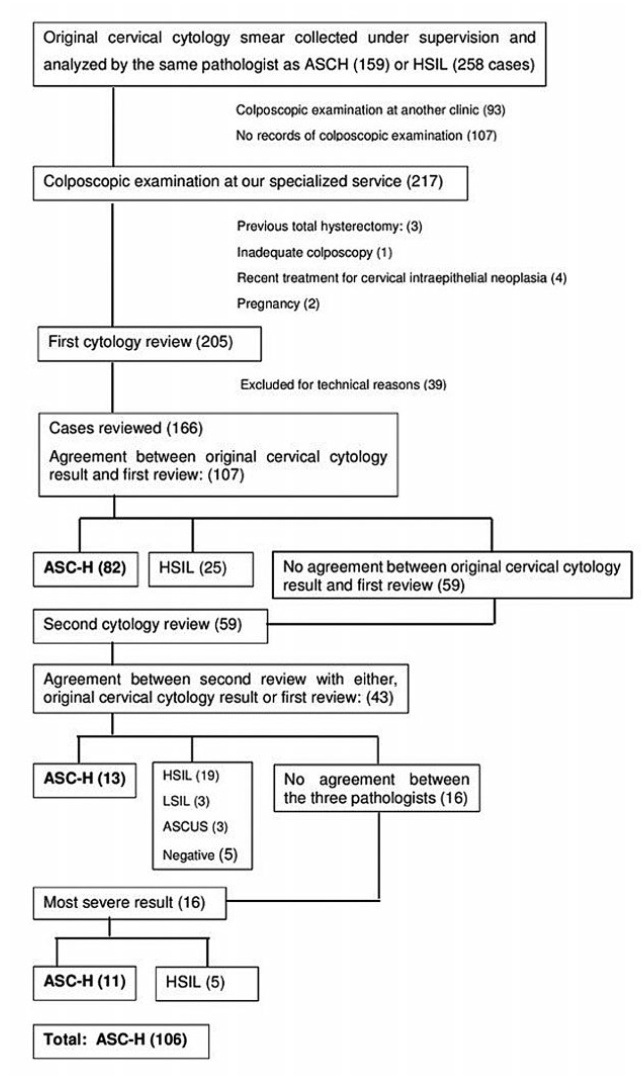
Summary
Revista Brasileira de Ginecologia e Obstetrícia. 2013;35(4):178-184
DOI 10.1590/S0100-72032013000400008
PURPOSE: To analyze the climacteric symptoms, nutritional status and distribution of abdominal fat in postmenopausal women using or not hormone therapy. METHODS: exploratory analytical study of the population survey type in the urban area of Maringa, Parana, conducted on 456 postmenopausal women aged 45 to 69 years. Data collection was based on the urbanized census sector (368) of the municipality, according to the Brazilian Demographic Census. A simple random sample proportional to women residing in each census sector was used, and a questionnaire was applied during a home visit, when anthropometric measurements were performed and blood pressure was determined. The Blatt and Kupperman Menopausal Index was used for the evaluation of climacteric symptoms. The outcome variable was the use of hormone therapy. RESULTS: Mean subject age was 58.7 years. Overweight was present in 72.6% of the women and abdominal obesity in 81.4% of them. Mild climacteric symptoms were observed in 69.5% of the women. Only 18.4% of the women studied were using hormone therapy and they were white, non-smokers, had no comorbidities, and had a partner. Users of hormone therapy had a lower frequency of overweight and obesity and had a lower prevalence of severe climacteric symptoms. CONCLUSION: Overweight and obesity were prevalent in this sample. Although fewer in number, the hormone therapy users had a lower frequency of overweight and mild and severe menopausal symptoms during the postmenopausal period.